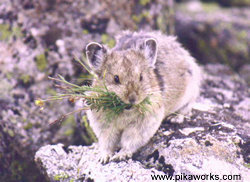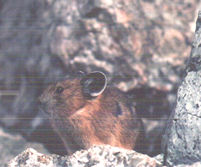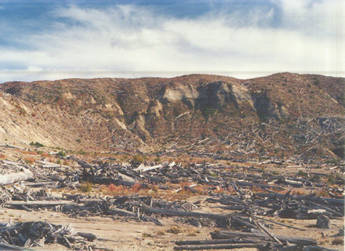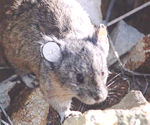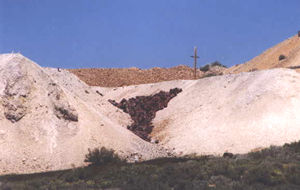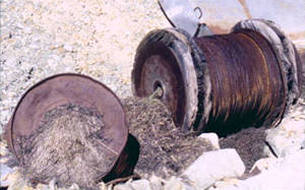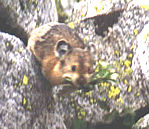| Erik
Beever's Pika Research Continues to Draw Attention Erik Beever's research on the possible causes of the disappearance of some pika populations in the Great Basin in the western U.S. continues to draw attention and discussion. Richard Hill wrote an article called "The Pika's Predicament" in September 17,' 03 issue of The Oregonian. In that he lays out Beever's observations about the possible effects of global warming and relays the experience and thoughts of other pika researchers including David Hik and Chris Ray. You may be able to get to this in the archives of The Oregonian via Oregonlive.com.
|
| Jeb
Bevers Studied the Return of Pikas to Mount St. Helens After reading The Oregonian news article, Jeb Bevers wrote to Pika Works to say that he had completed his doctoral studies on pikas recolonizing Mount St. Helens. Pikas sure are resourceful and creative. The following is a description of what Jeb found along with a few photos of the Mount St. Helen's pika and his new habitat post eruption.
"Ecological data and molecular work supported that the founding individuals in the blast zone originated from surviving pikas on the south side of Mount St. Helens, which was not directly impacted by the 300 plus mph winds of the eruption blast. Protein comparisons of pikas in the blast zone to ones surrounding Mount St. Helens and Mt. Hood in Oregon indicated rapid genetic divergence from the non-blast zone pikas. These genetic changes are likely due to microevolutionary processes such as the founder effect or natural selection. Small founder populations are frequently subject to increased random genetic drift - a shifting of the new isolated population frequencies away from the original parental population. "Two colonies of pikas were found to be inhabiting a habitat shift (using atypical habitat). These sites had piles consisting of a conglomerate of lake sediment, ash, and logs from the blown down trees, rather than the typical rock piles. The lake sediment was deposited from a tidal wave on the northern shores of Spirit Lake. The tidal wave was a result of an avalanche debris from the northern side of Mount St. Helen during the eruption. "Vocal differences between Mt St. Helens populations and Mt. Hood populations indicated that pikas on the Oregon side of the Columbia River appear to have a southern 'drawl'. This is supportive of other studies indicating that isolated populations of pikas develop distinctive dialects. "Additional work (2000-2001), with Will Simpson, in the Oregon side of the Columbia River Gorge located pika colonies lacking haypiles, or winter food caches of vegetation that all North American pikas are thought to have. The abundant vegetation and relatively mild winter climate in this banana means that these pikas are free to forage through the winter without relying upon the food reserves that their higher elevation relatives are obligated to put away for survival."
|
|
|
Chuck Bollinger's Pika Observations from Oregon "I just read a sobering article about the pika's plight, by Richard Hill in The Oregonian, and then I checked out pikaworks. I have some info that may be conflicting in places, helpful in others, or perhaps neither, due to the passage of time. "For about 18 years I lived near the mouth of the Columbia Gorge, and hiked hundreds of miles of Gorge trails. Pikas were common in the rockslides on the Oregon side (north-facing), but I never saw them on the Washignton side (south-facing), though that doesn't mean they weren't there. It's been about four years since I hiked Angels Rest Trail, which is only a few miles east of Portland. The trail begins near old Highway 30, at about 200 feet above sea level, and the first talus slope is less than a half mile up the trail. The last time I was there the pikas were still there. I heard one, than sat down and waited no more than five minutes before one showed itself. The bottom of the talus is near a house in full view, making this the only place I've seen pikas so close to a permanent human dwelling. I've worried that plinkers would shoot the pikas--they'd be an easy target--or that pikas would become prey to domestic dogs or cats. "Another place I've seen pikas at lower elevations than you mention is southeast of Molalla, Oregon, on BLM land. Again, they were present in north-facing talus slopes as low as 1,500 feet. At this site a few years ago, while working on a Pacific yew study (with the Pacific Northwest Forest Research Station), I watched pikas harvest and stack branches and twigs of Pacific yew, which in that area they seemed to prefer over everything else. If indeed the pikas at these sites in western Oregon prefer northern slopes, it might be because south slopes are too hot for them, which would be in agreement with the article. But maybe I didn't see them on south-facing slopes because I was there in the warm part of the day, and the pikas were in the cool, cool ground snoozing. "If I were asked for an opinion on causes of the growing paucity of pikas, at the top of my list would be coyotes. In eastern Oregon the jack rabbit population is way down, and range ecologists I've talked to believe it's because of the high population of coyotes. Though coyotes are thought to be new-comers (relatively) to the forested region west of the Cascades, they are firmly established now, even in urban-suburban areas. Last year a coyote boarded MAX, the commuter train, at Portland International Airport, and took a window seat for the ride to town. Some killjoy wildlife officers captured it and released it in the wilds. Coyote droppings are common on the Gorge trails. At least one sample I noticed had what I thought was pika hair in it, though I'm not sure about that. "I'm not saying that changing climate is not a factor. Since I've lived in northern I've seen a number of species from the south show up here (my observations are not scientific), or increase in number, including scrub jays, lesser goldfinch, snapping turtles, a California Calamagrostis (jointgrass), Castaniera spiders, et. al. Maybe climate change is the driving factor in the pika situation." Chuck Bolsinger lives in Boring, Oregon. He wrote to Pika Works in September, 2003. |
| Pika
Sculptures at the Oregon Zoo Did you know that there are two pika sculptures at the Oregon Zoo in Portland? Harry Cole kindly visited and took photos. |
 |
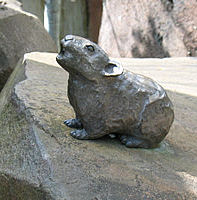 |
Pikas
are in the Running for being Named Cutest Animal in North America
|
Don't forget to visit more pikas or send a Valentine's Day e-postcard. POSTCARDS
| All Designs |
|
| Art Gallery |
|
| Originals/Giclee |
|
| Pikas |
|
Home |
About
Pika Works | Privacy & Policies |
Links | Licensing
| Contact Us |
